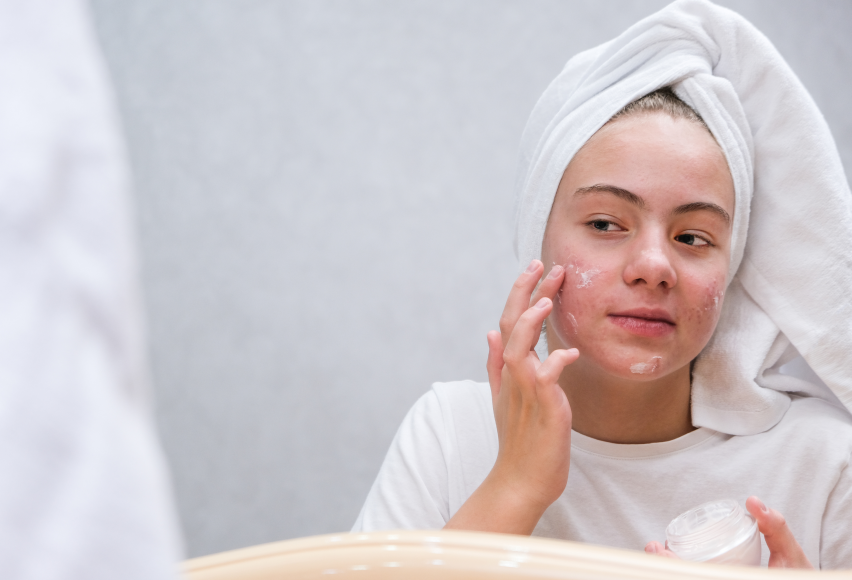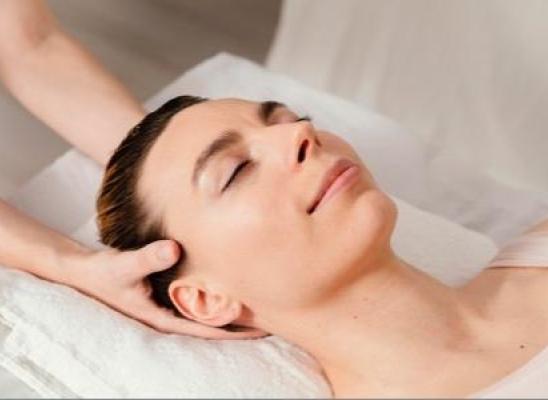Healing Wounded Skin: Tips for Gentle Skin Care

Online test
Find out the severity of your symptoms with this free online test
Skin picking, clinically known as excoriation disorder or dermatillomania, is more than just a bad habit. It’s a condition that not only affects your mental health, but it can also leave your skin damaged and sometimes even scarred. Therapy is an important step in your healing. But what about the skin damage that remains?
The good news is that your skin is resilient! How you care for your skin during your recovery process can make a big difference in how it heals too. With gentle, consistent care and patience, healing is possible.
Tips for Healing Wounded Skin
Keeping your skin clean and nourished is the foundation of healing and healthy skin.
Keep It Clean
Clean skin is less prone to infection, which is especially important if you’ve picked to the point of open wounds.
Gently wash the area twice a day with a mild cleanser. Avoid harsh soaps, scrubs, or alcohol-based toners. Gently pat the skin dry with a clean towel and always wash your hands before and after touching healing areas.
If you have open wounds…
Open wounds are at risk for infection and scarring, especially if the wound gets infected. These tips from a leading dermatologist can help:
- Clean your wounds daily with chlorhexidine or iodine. Do not use alcohol as it stings.
- Apply antibacterial ointment
- Use appropriate wound dressings. Avoid dressings that can “stick” to a wound. Ask your pharmacist for assistance.
- For facial lesions, clean as above, then apply acne hydrocolloid patches. The patches provide a clean & moist environment for wounds to heal. They also act as a way of giving you feedback if you re-pick these spots.
Replenish the Skin’s Protective Barrier
Skin that’s been picked is often dry, flaky, or scabbed. A good moisturizer helps to maintain the skin’s natural moisture barrier which keeps the skin supple, and aids in healing. Hydrocolloidal patches (sometimes called “pimple patches”) or petroleum jelly (Vaseline) can be simple and inexpensive ways to lock in that moisture and are often recommended by dermatologists. Other ingredients that might be helpful include:
Colloidal oatmeal – moisturizes and reduces inflammation
Ceramides - to rebuild the skin barrier
Apply moisturizer after cleansing and throughout the day as needed. If you’re healing scabs or open areas, a thin layer of Vaseline can protect while the skin repairs itself.
SPF Is Your Skin’s Friend
Sunscreen does more than just protect the skin from sun damage and skin cancer. It also helps to reduce the hyperpigmentation that can come with skin wounds and scarring. Dermatologists recommend daily use of a broad-spectrum sunscreen with SPF 30 or higher. They also recommend using sun-protective clothing to further protect exposed skin.
Hands Off! Let Scabs and Wounds Heal Naturally
Sure, it’s tempting to want to “help” the skin along by picking at scabs or flakes. Not only does that reinjure the skin, but it can also trigger the picking cycle. Try redirecting your hands and attention to something else like a fidget toy. Those hydrocolloidal patches can help here too by creating a barrier and by giving you a tactile cue that you’re touching that area.
What About the Scars?
Scarring can be complicated to address but there’s good news here too!
Not all post-picking marks are permanent. Some may fade on their own with time, while others may benefit from targeted treatments. Some ingredients that can help with scarring and recommended by dermatologists may include:
- Topical Vitamin C
- Niacinamide
- Licorice root and other botanicals
- Sunscreen (it’s not just to prevent sunburn)
We can’t talk about scar management without mentioning laser treatment. Dermatologists use different types of lasers to treat scarring, depending on factors such as the type of scarring, depth, and skin type. While laser can be a useful tool, it isn’t without risks and should be discussed thoroughly with your dermatologist.
Healing Takes Time
Skin heals at its own pace. It can take days or weeks for a wound to heal and even longer for the discoloration and scarring to fade. Reaching out to a dermatologist can help you find the skin care practices that are right for you.
You can’t speed up time, but you can maximize the time by showing up for yourself every day. The healing steps you take on a daily basis add up over time and each one contributes to your healing, both physical and emotional.
Moving Forward
But healing after skin picking isn’t just about your skin. It’s also about rebuilding a sense of trust and self-worth and working to heal the deeper issues that trigger the picking. Therapy can help you understand and learn how to cope with those deeper issues.
If you’re ready to take that next step, SkinPick can help. We have a team of experienced therapists ready to help you find growth and healing. And with online therapy, you can see a therapist when and how it works best for you. Healing is possible.
References
1. Skin Picking Disorder: Wound Care. (n.d.). Retrieved from https://drdavinlim.com/skin-picking-disorder-wound-care/
2. Proper wound care: How to minimize a scar. (n.d.). Retrieved from https://www.aad.org/public/everyday-care/injured-skin/burns/wound-care-minimize-scars
3. Cleveland Clinic. (2025, January 23). Colloidal oatmeal: What is it and what are its benefits? Retrieved from https://health.clevelandclinic.org/colloidal-oatmeal
4. Li, Q., Fang, H., Dang, E., & Wang, G. (2020). The role of ceramides in skin homeostasis and inflammatory skin diseases. Journal of Dermatological Science, 97(1), 2-8. https://www.jdsjournal.com/article/S0923-1811(19)30370-6/abstract
5. Fatima, S., Braunberger, T., Mohammad, T. F., Kohli, I., & Hamzavi, I. H. (2020). The Role of Sunscreen in Melasma and Postinflammatory Hyperpigmentation. Indian journal of dermatology, 65(1), 5–10. https://pmc.ncbi.nlm.nih.gov/articles/PMC6986132/
6. Sunscreen FAQs. (23, July 19). Retrieved from https://www.aad.org/media/stats-sunscreen
7. Skin experts. (n.d.). Retrieved from https://www.asds.net/skin-experts/skin-treatments/laser-light-therapy/laser-therapy-for-scars
Online test
Find out the severity of your symptoms with this free online test
Start your journey with SkinPick
Take control of your life and find freedom from skin picking through professional therapy and evidence-based behavioral techniques.
Start Now



